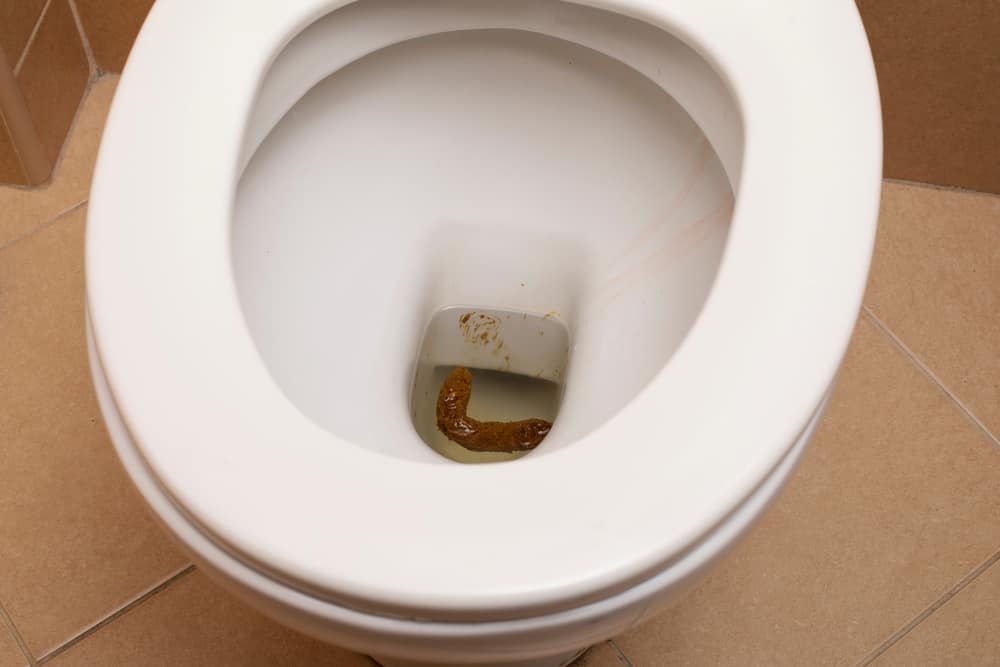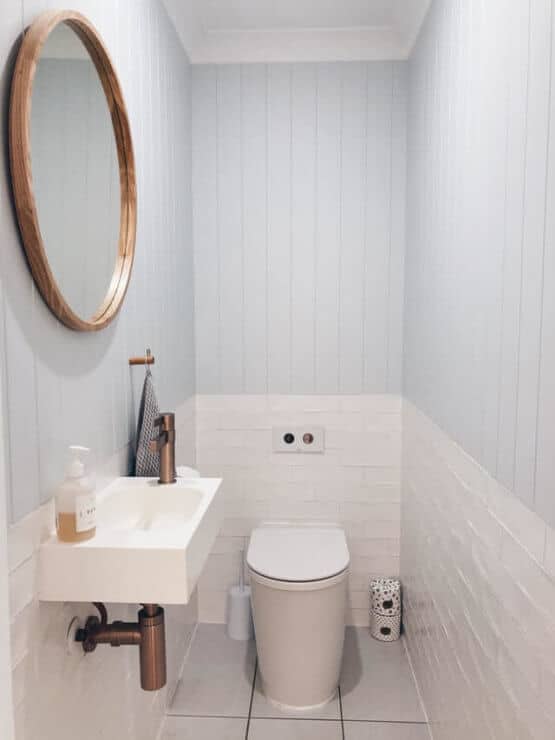Do you have a problem when the toilet flushes but the poop stays in the toilet bowl?
We’ve all had the frustrating experience of flushing the toilet. But instead of everything disappearing as it should, the poop stubbornly remains. It’s an embarrassing and challenging problem that can leave you feeling helpless and troubled over what to do next.
Whether you’ve experienced it yourself or heard stories from others, poop that won’t go away after a flush is a problem that can occur in any household. The most important thing to understand here is that poop not flushing down the toilet after you flush could be caused by several issues.
In this write-up, we will look at the most common causes for your toilet not flushing efficiently. We will also explore potential fixes to these concerns.
Why Does my Toilet Flushes But the Poop Stays?

Several factors can contribute to the problem when the toilet flushes but the poop stays. They include blocked drains or rim jets, a malfunctioning toilet tank, a poor or old toilet design, as well as an insufficient water level in the tank. Each of these factors is explored in detail below.
- A Blocked or Clogged Toilet Drain
The first and most obvious issue you might face here is a clogged toilet drain. Over time, the toilet drain usually accumulates mineral deposits, toilet paper, and other debris. This build-up can gradually narrow the passage through which waste is supposed to flow.
When this happens, it creates an obstruction that hinders the smooth movement of wastewater away from the toilet bowl. A partially blocked drain can result in incomplete flushing, which leaves poop in the bowl. In this case, you will notice that the toilet bowl fills up with water and then slowly drains after flushing.
Several possible solutions to a blocked toilet drain have been explored. The first recommended solution is to use a toilet plunger. Before you use it, however, ensure that it is completely covered with water and plunge vigorously.
If this does not work, consider using a toilet snake or a drain auger. The auger is inserted into the drain and rotated to dislodge any existing clog. And in case the clog persists, consider using a toilet-friendly drain unclogging chemical [1].
However, it’s essential to use one specifically recommended for toilets.
If none of these approaches seem to work, the last resort is to remove the toilet to inspect for obstructions. This is where you will need to call in a plumber to identify the exact issue behind the clog.
- Clogged Rim Jets
Another problem that may cause poop to stay after a flush is if the rim jets in the bowl are blocked. Rim jets are the holes through which the water from the toilet tank flows to start the flush cycle. Blocked rim jets are therefore unable to allow this flow, thereby rendering flushing difficult [2].
The issue will commonly occur when there is insufficient water flowing from the tank to the bowl in a short period. There needs to be sufficient enough water to generate the pressure needed to force all of the waste down. The rim jet blockage can be due to the accumulation of mineral deposits caused by hard water.
With time, mineral deposits in hard water, such as calcium and magnesium, accumulate and obstruct the jets. To resolve this issue, you need to consider several simple solutions. First, you might want to try pouring a vinegar and baking soda mix into the toilet tank and flushing it. This may be sufficient to clear those small holes [3].
Another option is to apply a chemical treatment that can eliminate hard water buildup. Removing the hard water buildup should be enough to unclog the holes and allow enough water to adequately flush excrement down the drain.
- Trouble in the Water Tank
In case the rim jets are working just fine, the problem could be with the water tank itself. In other words, there could be a faulty component in the water tank causing failure in the toilet flushing mechanism.
If you wish to troubleshoot and solve the problem, follow the procedure outlined here. First, ensure that the flapper and the chain are in good working order. If this component is not working as it should, there might not be enough water in the tank to flush the excrement down [4].
If you notice any problems with the flapper, chain, or floating ball, you will need to make the necessary repairs or replacements for your toilet to function. Now if you can’t identify the problem yourself or the required repair is beyond your knowledge, you can call a plumber to help.
- Low Water Level or Pressure
Effective waste elimination depends on the amount of water in the toilet tank. When you flush a toilet, the water in the tank and gravity work together to flush waste down the drain. Insufficient water will prevent the flow and momentum needed to efficiently push the solid waste down the drain [5].
The waste may therefore continue to stick to the toilet bowl. Similarly, low water level has low pressure. This means that the water will not enter the bowl with enough force to push the poop through the drain. To resolve this issue, find a way to increase the water level in the toilet tank.
Most toilets consist of a mechanism called a float that regulates the amount of water in the tank. You can enhance the performance of the flushing process by adjusting the mechanism to let more water into the tank [6].
- Toilet Design
Toilet designs can vary significantly. Not all toilets are equally efficient at waste removal. Older toilets, in particular, are often less effective due to outdated designs. These toilets typically use more water per flush and have less powerful flush mechanisms.
The reduced force may therefore not be sufficient to clear solid waste. In such cases, upgrading to a newer toilet with a more efficient design can make a significant difference. Modern toilets are designed to utilize as little water as possible [7].
This allows you to save money while also benefiting the environment. However, if there is a lot of waste in the toilet bowl, a toilet with such limited water per flush may not be able to handle the poop effectively.
- Flush Duration is too Short
In some instances, toilets are equipped with short flush durations. This means that such toilets release water into the bowl for only a brief period. While this design may contribute to water conservation, it can become problematic, especially when dealing with heavier waste.
The short flush duration will not provide adequate time for the waste to be fully expelled from the bowl and into the drain pipe. This will result in incomplete flushing and potential blockages.
To address this issue, one straightforward solution is to hold down the flush lever for longer. By doing so, you allow more water to enter the bowl, which increases the flushing power and improves waste removal efficiency.
Another option is to invest in a toilet with an extended flush duration. Modern toilets often come with dual-flush features, which offer two flush options. These include a longer flush for solid waste and a shorter flush for liquid waste.
The dual-flush toilet system provides greater control over water usage and ensures that solid waste is effectively cleared from the bowl. This ensures that the toilet disposes of waste with each flush while still maintaining its water-saving benefits. Addressing the issue of insufficient flush duration enhances the overall performance and efficiency of your toilet.
- The Plumbing System Is Too Old.
Perhaps your plumbing is simply old and outdated. In this case, your toilet will not have the capacity to manage such enormous amounts of water and garbage at once.
If you suspect that the trouble is with the plumbing system, the only practical answer is to contact a plumber for replacement. You will certainly need to replace your present plumbing with a modern design equipped with larger pipes that can handle more waste.
Modern plumbing systems are designed to meet higher demands and are more effective in preventing issues like clogs and wastewater backup. Upgrading your plumbing system not only resolves immediate toilet flushing problems but also offers several long-term benefits.
Advantages include improved water pressure, enhanced water conservation, increased overall plumbing system efficiency, and reduced risk of future plumbing-related issues.
When you choose to upgrade, you will guarantee that your plumbing system is now equipped to handle the demands of modern wastewater disposal. This will in turn translate to a more efficient and reliable toilet flushing experience.
Related: Comfort Height vs Chair Height Toilet
Conclusion
Having your toilet flush but the poop stay in the bowl does not need to seem like the end of the world. Most of the time, this is a quick repair. Sometimes flushing once or twice will be enough to fix the problem.
However, other cases may need the use of various appliances, such as a plunger, to break up a clog and get everything to move. Other times, you may need to play with your tank hardware or even use a mixture of baking soda and vinegar to coax stubborn waste from your toilet bowl once and for all.
Calling a plumber should only be used as a last resort, as most toilet problems may be fixed using the strategies given above. So, the next time you come across a troublesome toilet, you should be ready to handle it and prevent any uncomfortable situations.

Michael Davis is a heating & plumbing expert who currently works as independent contractor in SC. He also writes for Plumbertip.
For almost 10 years he worked on various plumbing tasks across South Carolina.


